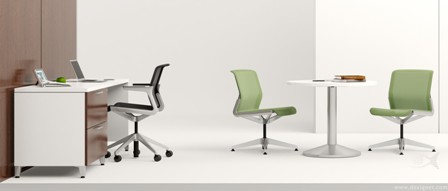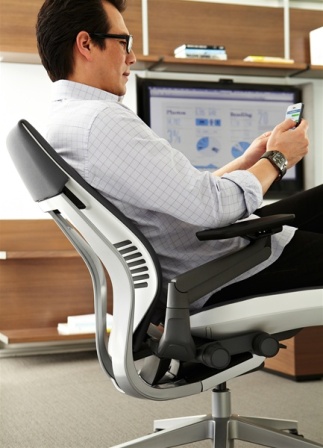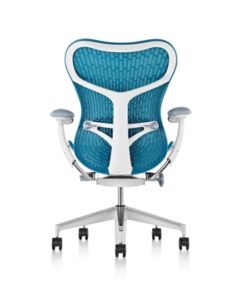Anthropomorphic, the new Ergonomic: Task seating takes human form to adapt to technology
by Lisa Mulcahy
When the first proclaimed ergonomic chair was unveiled in 1976 by Herman Miller its designer Bill Stumpf probably could not have dreamed of the technology that was to come within the next 40 years. Since then typewriters have given way to word processors, word processors to PCs and now PCs to mobile devices. The real-time result: the cubicle farm is dead and collaboration is king. Technology has unchained us from our desks, but now what?
As Alan Hedge, Professor of Ergonomics, Cornell University, says, “It’s pretty hard to use any workplace technology for an extended period of time if you’re standing up. Every living organism seeks to lessen the strain exerted upon itself.” Simply put, people prefer to sit in some shape or form for the majority of the day. The challenge lies in meeting the multiple work styles and physical requirements of a wide range of people in a way that promotes health and wellness. “If you weigh the overall cost for an employee’s salary, worker’s compensation for an injury, and loss of productivity, it’s really a no-brainer that the best place for an FM to allocate money is ergonomic seating,” continues Hedge.
Ergonomic solutions are a purchase with a high return on investment. The price tag is a reflection of research and development, high quality components and often, custom-tooled parts. The good news is that 3D printing is becoming more prevalent, allowing manufacturers to more quickly and easily design and produce parts.
No training required
Another cost factor to weigh is employee satisfaction explains Amy Smith, Seating Portfolio Manager, Allsteel. “If people like their environment, they’re more likely to be loyal to their company. Turnover is an expensive venture. Seating can play a major role in making employees comfortable and maximizing efficiency.”
But what do employees actually need? To be truly ergonomic, seating should provide supported motion throughout the day. The seat should become an extension of self and mimic the movements of the body. More and more you’ll hear seating described as anthropomorphic. To accomplish this, manufacturers are finding that weight-balancing mechanisms that automatically adjust to the user are a key factor for FMs. The chair should ebb and flow as workers come and go, and varied tasks achieved. It’s a fact that most employees do not regularly adjust their chairs. Likewise, most companies don’t set aside time to properly instruct their employees on how to use their chairs. A passive design allows for the widest-range of users, especially important considering that multiple people may be using the same chair throughout the day. “But even though seating is becoming more intuitive it’s essential not to lose sight of the individual,” says Lauren Gant, Ergonomist, Allsteel. “It’s all about the human factor.”
While most seating is designed for the 95th percentile, each person is unique and will have varying comfort levels and sitting habits. There should be basic adjustability for seat height and seat depth. If the user is working on mobile devices it’s also helpful to have the capability for a deep recline with neck support.
“For the most part, the eight-hour task intensive days are gone,” says Shawn Green, VP, Design and Product Marketing, KI. “FMs should weigh how much task intensive work vs. collaborative work is being done. Most employees do not need a $1,000 plus task chair. The fastest growing sector of the market is mid-range products that have solid design and built-in simplicity.” This is a reflection of changing work styles and employees on the move. “We’re seeing more benching workstations and impromptu meetings where people wheel their chair over to a co-worker or to a nearby round table,” says Julie Stadtmueller, Product Marketing Manager, KI. Stadtmueller suggests that FMs look at a variety of seating options. There’s no longer the standard issue chair company-wide. Most work environments break down into task-based, collaborative or simply touch down. Allocate funds accordingly.
There’s also the growing popularity of adjustable-height worksurfaces. “People are now working at desk height, lounge height and counter height,” comments Christine Dominik, Director of Product Management, Design, Marketing and Sustainable Development, Teknion. “From an ergonomic perspective, flexibility and movement drive seating solutions.”
Flexibility and movement have also influenced our social and organizational structures. “Workers are less formal,” says Bruce Smith, Director of Seating Design, Steelcase. “People are adaptive and inventive. Their circumstance directly effects posture.” Steelcase conducted a global study in 11 countries, observing over 2,000 people in a wide range of environments and postures. Company researchers discovered nine new postures that were a result of new technologies and new workplace behaviors. If not adequately addressed, these postures can cause pain, discomfort and long-term injuries for workers.
Making motions in the workplace
“People shouldn’t be static. There should be dynamic motion,” explains Sandra Bowie, Director of Marketing, Motion Seating Division, Via Seating. In fact some Via Seating products like the Swopper are being recommended by chiropractors and insurance companies to get employees back to work after injuries. “There’s a growing problem of presenteeism,” continues Bowie. “We strive to get employees what they need to be comfortable so they can maximize their performance.”
In what was probably the biggest shift in the seating market since the 1970s, motion products were first seen as a trend
, but most experts agree it’s a category that’s here to stay. Aside from providing alternative ways to sit and support the body, motion-based seating is transforming the landscape of the modern office. We’re a workforce on the move, and in many cases there are four generations co-existing within one space. There’s not going to be a standardized solution for everyone. Some of the larger corporations are establishing their own ergo labs where they bring in multiple seating options for their employees to demo. Bowie admits there’s a learning curve with this category. If an FM all of a sudden swapped out traditional task chairs for Swoppers without training employees first, it might not be a successful transition. “But once people are informed of the research behind the product and its benefits of use they’re eager to try it,” says Bowie.
What’s next? Just as we can look back at the ways in which work has changed since Stumpf’s time, surely the same will be done a decade from now. But a peek at the future may be the Axia Smart Chair from the Netherlands-based company BMA Ergonomics. Not yet available to the American market, this chair has sensors built in to alert its user of incorrect posture. Sit too long in one position or in an unhealthy posture, and it will vibrate as an alert to move. New for 2014 it will also have the ability to push data to a smart cloud to collect and report data through multiple devices. FMs could receive a daily report on how effectively seating is being used and which employees may be at risk for injury.
How we work and the technologies we use will ultimately dictate the type of seating required. Ultimately it’s in the facilities’ managers hands to assess and allocate resources accordingly. With the lightning speed at which technology is moving this is a constant process, but one in which seating manufacturers are up for the challenge.
Lisa Mulcahy is a freelance writer, editor, and project manager who served on the editorial staffs of FACILITIES Design & Management magazine and Contract magazine. She is a project manager on the Best of NeoCon and the Nightingale Awards.






